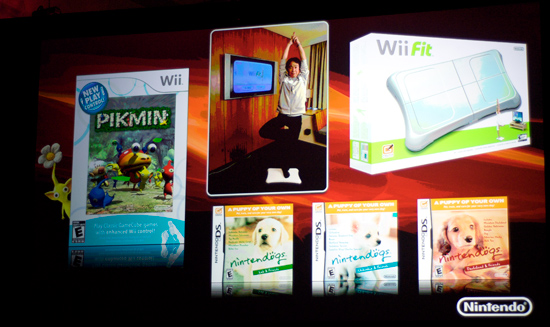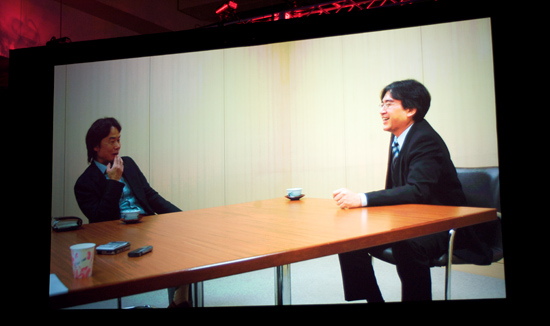Nintendo's Development Secrets, Cloud Gaming & new Killer NIC - GDC '09
by Anand Lal Shimpi & Derek Wilson on March 26, 2009 12:00 AM EST- Posted in
- Trade Shows
Miyamoto’s World
Miyamoto draws his inspiration from observation. He looks at other humans and watches how they interact, what they enjoy doing, etc... When he sees an activity that people enjoy he focuses on why they find that activity so entertaining. He thinks about things that most people just glaze over; most people know when they’re having fun, they don’t focus so much on why they’re having fun. He analyses himself and others in order to discover new ways to develop games that capture the fun people already know how to have. Miyamoto draws his inspiration from the life around him; he doesn’t sit down to make a game, he looks at what he and others enjoy in life and uses that to spark the innovation.
Iwata gave two examples; the first was when Miyamoto got a new garden, Pikmin shortly followed. And when Miyamoto got a new dog? Nintendogs came about.

With the idea in mind, Miyamoto uses basic personal communication to start talking about it. He grabs a very small team and doesn’t do anything formal, they just talk. Miyamoto is all about personal communication, and that’s what happens here.
The next stage is to take this small team and begin prototyping the game. There’s no need for polish here, or anything other than the core concept of the game. As an example, this was the original prototype of Wii Boxing:

It’s not particularly attractive. There are no impressive shaders being used here. Miyamoto simply wants to test the basic mechanics of the game to see if it’ll be fun. The prototype stage is only concerned with the simple idea itself; don't worry about extraneous details - just core gameplay.
These small prototyping teams are sometimes only one developer large. There are often multiple projects in the prototype stage at the same time. This prototype stage can sometimes last as long as two years; not every concept ever makes it out of this stage, but Miyamoto never throws away the work that’s been done. While a prototype game or feature may not be used for the current project, it may come in handy somewhere down the line. Iwata said that he often times saw prototypes show up in games further down the line in ways you’d never expect.
It’s impossible to know what will be fun without trying it first. Miyamoto employs extensive use of trial and error in his prototyping stages, but that’s the beauty of not building fancy prototypes. If the concept doesn’t work, there’s not much extraneous work lost - it was simply a learning experience.

Miyamoto (left) and Iwata (right)
When a prototype succeeds, then and only then can the game get to a planning stage. This is where the documents come out and we start seeing some structure. With the core gameplay already defined, the next stage is mass production where the actual game is put together. The approach is very front loaded; if the core gameplay is done properly thanks to a well executed prototyping phase, building the rest of the game can go smoothly and according to schedule.
While the mass production stage is usually predictable, sometimes it does yield surprises. One of Miyamoto’s traits is that he never gets angry with his team when things don’t go according to plan. Mistakes are made and instead of a yell-fest, Miyamoto will even go as far as to personally help get things back on track. Iwata talked about it like someone turning a table upside down; Miyamoto helps pick up the pieces and put it back in order, rather than complain about the mess that was just made.

Because of Miyamoto’s aggressive focus on the prototyping stage, a game never needs to be restarted from scratch once it’s at the mass production phase. The prototype stage produced a well defined core concept. Sometimes ideas need to be dropped from the title because they don’t work out, but as I mentioned before, Miyamoto saves the ideas and can reuse them in later completely unrelated projects.
Iwata spoke of the “Death Spiral” in game development. Game developers face financial pressure to get games out on time; the developers rely on game sales to fund both current and future projects, so without that revenue stream there’s no hope for game development to continue. The financial pressure leads to less time to work on and perfect a game, which then leads to poor quality and poor sales. The spiral continues downwards until the developer can no longer remain competitive in the industry.
Iwata himself saw this death spiral first hand, as his previous job as a developer left him with 2 days to ship a title that needed months worth of work. Iwata sacrificed the quality due to sales pressure and eventually had to help restructure his company (HAL Laboratory) for bankruptcy. A much younger Iwata blamed finances alone for his employer’s failure as a game developer, but today Iwata believes that it has just as much to do with talent and approach to game development. His change in perspective is thanks to one man in particular: Shigeru Miyamoto.
According to Iwata, it’s Miyamoto’s methodical yet youthful approach to game development that gives him, and thus Nintendo, the edge. Iwata’s goal was to share one of Nintendo’s secrets success with the game developers in the audience. I just liked knowing how someone as significant as Miyamoto goes about his job.










38 Comments
View All Comments
wilkinb - Thursday, March 26, 2009 - link
in woW latency can be a big deal...Stop casts in pvp or boss fights are a lot harder when you have high ping times and the cast times are short....
Also timing CD's right time not be on shot...
Sure if you are just doing easy content or dont care about arenas then it doesnt matter... but the same can be said about FPS...
Also people keep saying wow isnt prashically intensive.. this again is true when you stand by your self... when you are on say a WG battle ground with say 160 other players adn all their spell effects... there are a lot of polygons... It runs slower then crysis for example.
MOO's have to deal with more scaling issues then FPS.
MMO's have the issue f
wilkinb - Thursday, March 26, 2009 - link
no idea what happned to some of that text :(wtb edit.
randomname - Thursday, March 26, 2009 - link
"I'm sure the video latency will be at least a second."In Dean Takahashi's article:
"A packet can make an entire round trip in 80 milliseconds, a very short amount of time compared to other Internet traffic that travels through hardware that either compresses or decompresses the data."
I'm assuming that 80 ms has all the essential stages included. Which would be supported by Anand's claim that Bioshock felt like Bioshock.
Nevertheless, lag, reliability and bandwidth are probably the only obstacles here. All of which can be further improved. Bandwidth-wise, once you get to Blu-Ray -quality 40/48 Mbps, or at least when you get to 1080p60 4:4:4 -quality, additional bandwidth won't get you anything, really. On the server side, you would only have to buy a fraction of the number of consoles/computing hardware compared to every user buying one. And if you can do it with games, you can do it with all programs and media.
SSDMaster - Thursday, March 26, 2009 - link
80ms? Okay, wonderful. I have to wait .08 Seconds till I can move my cross hairs over someone's head which is only going to be in that specific location for another .02 Seconds.FPS's are too fast paced for this... Especially UT 2004 types.
Maybe you could play a horrendously slow paced FPS like Halo or something.
Also, the US internet backbone just cannot handle this kind of streaming. Comcast gives me a 30mb connection for about 7 minutes. Then they cap it back to whatever I "really" have, which is a 6mb connection. Which "should" be enough unless everyone starts using onLive... Then I'm sure Comcast won't even be able to give me 6mb.
My last point. Internet packets don't always arrive on time or in order, its not like you have this one internet (pipe) to your computer. Think of a stream full of rocks, and your packets (water) are taking tons of different paths, all around these rocks.
That's really not a good enough illustration but I think you guys get the point. If you have a router between you and onLive server's which is bogged down but still working; then your connections going to suck. Not all routers prioritize packets.
Modeverything - Thursday, March 26, 2009 - link
I think one solution to this could be to use UDP instead of TCP.Today's networks are not the ones of a decade ago when packet verification was needed. Packets rarely get lost anymore, and if you lose a single packet, big deal, you probably won't notice anyway.
If OnLive were setup to use UDP transmission, I think it would work.
overzealot - Friday, March 27, 2009 - link
It's a latency-critical app, they're definately going to use UDP, possibly with a layer of RTP(or similar protocol)andrihb - Thursday, March 26, 2009 - link
Think of them as a series of...Calin - Thursday, March 26, 2009 - link
Latency might not be a big deal in World of Warcraft - but remember that people balk at the idea of TFT monitors showing the image from 3-5 frames back - that's less than a tenth of a second. If you're talking about Internet-enabled gaming, you should consider the ping response time you get from a server when you're streaming something (from the same server, probably). Let's say ping to a game server while streaming high quality video.The bandwidth really needs to increase for this, and the latency needs to go down.
As for adaptive quality based on usable bandwidth, you don't know when you're reaching your bandwidth, you only know when you're surpassing it, so that makes the game stutter (too low a bandwidth = lost packets), then go sometime in low quality mode, and then go again in high quality mode. For high quality games, the server would need the equivalent of a high-performance recent-generation video card and CPU for every gamer out there, and the hardware or CPU to compress that stream (video and audio)
It will probably happen, but it's a long time into future